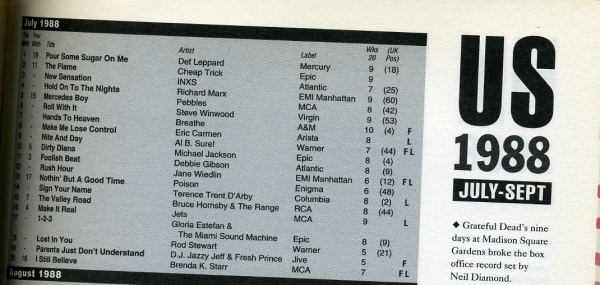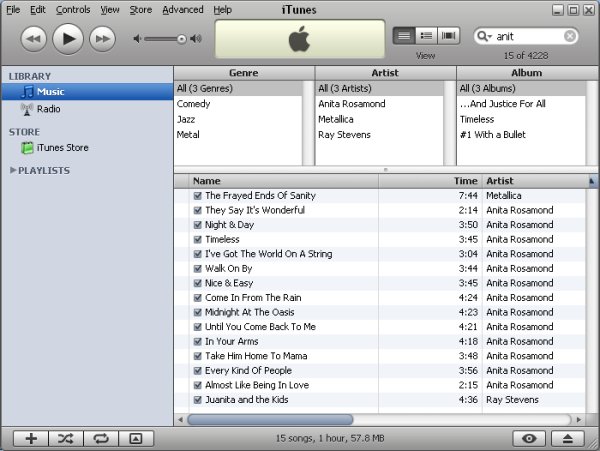My beautiful wife got me a set of musical reference books from a garage sale or book fair. The titles include The All Music Book of Hit Singles which compiles the top 20 singles by month from 1954 through 1993 and provides the results in monthly charts for the United States and the United Kingdom on opposite pages so you can compare the two. Each page has three such charts and 3-4 bullet points of trivia for the quarter. I thought I could go through these charts as my nightstand book, a book I read in very small snippets in the 10-15 minutes preceding sleep on the occasional nights where I am in bed and the lights are on for those minutes. Ultimately, it wasn’t a good choice, because I found myself opting for sleep rather than reviewing historical charts (I only made it to 1959). So as I took the book from the nightstand and removed the bookmark, I flipped it open to the late 1980s, a time period where I was more directly related to the music on the charts.
The book fell open to July 1988, and suddenly I was there:

I don’t mean I was suddenly at the page, because although I was suddenly on that page, that’s not worth commentary. No, friends, suddenly I was in July 1988.
It’s late at night. We only got to stay up until 9pm (well, we had to be in our rooms at 9pm, but the de jure 9pm evolved to de facto 10pm or thereabouts) on school nights (in high school, no less). In July, 1988, we’ve moved from the mobile home in Murphy to the single family home down the old gravel road (Ruth Drive, or Route 5 alternately but less so at that time). The house was far into a valley from the nearest two lane state highway (MM, which runs from House Springs through Otto and onto Antonia); if we were so inclined, we could walk about 30 minutes to that T intersection where Heads Creek Road met MM, but rarely did, since it was another 40 minutes to Otto or an hour or more to House Springs on the two lane, no shoulder highway. At the time we moved in, the valley offered spotty television reception from St. Louis and did not have cable television. Or private telephone lines. At the end of Ronald Reagan’s presidency, we still had to pick up the phone receiver and make sure none of our neighbors was using the line before placing a call. Party lines, they called them.
But I didn’t have to worry about that late at night. Or much during the day, either; we weren’t the most popular children.
Our mother took great pride in moving us way into nowhere where she could afford $40,000 worth of house on over an acre of land, most of which was flat. We had trees, we had a lawn that it took 3 hours to mow with push mowers (not reel mowers, thankfully), and we had a shady spot with poisonous snakes. We even had one or two kids who didn’t want to beat the snot out of us on sight. The house itself was a ranch with an attached two car garage and a full unfinished basement. Three of the bedrooms were bedrooms, and a fourth room that could advertise as a bedroom (with basement access) served as our computer room. A grey computer desk held our Commodore 128 (yes, that desk). I spent many nights that summer seated on the wooden folding chair in front of that grey/beige keyboard, typing programs in from Ahoy!, Compute’s Gazette, Run, and Commodore Power Play into memory and saving them onto old floppies.
While I typed those old programs in, a shelf audio system with cassette deck, turntable, and tuner played the songs from that chart. It would have been Y 98; 103.3 KHTR had already changed to oldies a couple years before. Y 98 hasn’t altered its format that much and still uses the KYKY designation, so it’s probably due to change to smooth jazz any time now.
I can almost close my eyes and remember the bookshelves to my left, the battered metal office desk to my right holding an ancient Remington electric typewriter and a 1960s styled electronic word processor that could save your documents to cassette and could print them on rolls of paper. Even then, once in a while, a feeling of future nostalgia would wash over me and I would press the sounds of the trees outside the window and the stillness of the house into my memory for someday. Somedays like today.
My brother was just turning toward the harder rock, so he would have favored “Pour Some Sugar On Me”. “Make Me Lose Control” and “The Flame” both acutely remind me of that particular era and, indeed, the particular selfshot of me at the computer, trying to proofread typos or to enjoy the always disappointing simple little games that resulted. Late at night, me and that Commodore 128 after everyone had gone to bed. Until the cable company pulled its lines and private phone lines behind it, I wouldn’t even have Bulletin Board Systems again. Just me, that radio, and the Miami Sound Machine or the soul of “Terence Trent D’Arby”, whom I mocked then and continue to mock now. Some years later, I would have disposable income and would own a number of those songs on cassette or 45, but then I only had the radio and the endless time of youth in the summertime, nights to spend typing from magazines and dreaming of a future whose days and nights matched those, but better.
And here I am.




